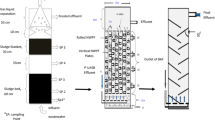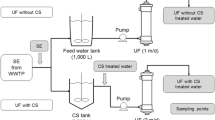Abstract
Large-scale wastewater schemes rely on multi-barrier approach for the production of safe and sustainable recycled water. In multi-barrier wastewater reclamation systems, conventional activated sludge process (ASP) often constitutes a major initial treatment step. The main aim of this research was to determine most appropriate sampling approach to establish pathogen removal efficacy of ASP. The results suggest that ASP is capable of reducing human adenovirus (HAdV) and polyomavirus (HPyV) by up to 3 log10. The virus removal data suggests that HAdV removal is comparable to somatic bacteriophage belonging to Microviridae family. Due to the high removal of Escherichia coli (>3 log10) and very poor correlation with the enteric virus, it is not recommended that E. coli be used as a surrogate for enteric virus removal. The results also demonstrated no statistically significant differences (t test, P > 0.05) in calculated log removal values (LRVs) for HAdV, HPyV, and Microviridae from samples collected on hydraulic retention time (HRT) or simultaneous paired samples collected for influent and effluent. This indicates that a more practical approach of simultaneous sampling for influent and effluent could be used to determine pathogen removal efficiency of ASP. The results also suggest that a minimum of 10, preferably 20 samples, are required to fully capture variability in the removal of virus. In order to cover for the potential seasonal prevalence of viruses such as norovirus and rotavirus, sampling should be spread across all seasons.



Similar content being viewed by others
References
Asano T, Cotruvo JA (2004) Groundwater recharge with reclaimed municipal wastewater: health and regulatory considerations. Water Res 38:1941–1951
Bixio D, Cikurel H, Muston M, Miska V, Joksimovic D, Schäfer A, Ravazzini A, Aharoni A, Savic D, Thoeye C (2005) Municipal wastewater reclamation: where do we stand? An overview of treatment technology and management practice. Water Sci Technol Water Supply 5:77–85
Carducci A, Verani M (2013) Effects of bacterial, chemical, physical and meteorological variables on virus removal by a wastewater treatment plant. Food Environ Virol 5:69–76
Carducci A, Morici P, Pizzi F, Battistini R, Rovini E, Verani M (2008) Study of the viral removal efficiency in a urban wastewater treatment plant. Water Sci Technol 58:893–897
Carducci A, Battistini R, Rovini E, Verani M (2009) Viral removal by wastewater treatment: monitoring of indicators and pathogens. Food Environ Virol 1:85–91
Chauret C, Springthorpe S, Sattar S (1999) Fate of Cryptosporidium oocysts, Giardia cysts, and microbial indicators during wastewater treatment and anaerobic sludge digestion. Can J Microbiol 45:257–262
Costan-Longares A, Montemayor M, Payan A, Mendez J, Jofre J, Mujeriego R, Lucena F (2008) Microbial indicators and pathogens: removal, relationships and predictive capabilities in water reclamation facilities. Water Res 42:4439–4448
Dillon P, Toze S, Page D, Vanderzalm J, Bekele E, Sidhu J, Rinck-Pfeiffer S (2010) Managed aquifer recharge: rediscovering nature as a leading edge technology. Water Sci Technol 62:2338–2345
Fong TT, Phanikumar MS, Xagoraraki I, Rose JB (2010) Quantitative detection of human adenoviruses in wastewater and combined sewer overflows influencing a Michigan river. Appl Environ Microbiol 76:715–723
Gantzer C, Maul A, Audic JM, Schwartzbrod L (1998) Detection of infectious enteroviruses, enterovirus genomes, somatic coliphages, and Bacteroides fragilis phages in treated wastewater. Appl Environ Microbiol 64:4307–4312
Gerba C, Kitajima M, Iker B (2013) Viral presence in waste water and sewage and control methods, viruses in food and water: risks, surveillance and control. Woodhead Publishing Ltd., Cambridge, pp 293–315
Haramoto E, Katayama H, Oguma K, Yamashita H, Tajima A, Nakajima H, Ohgaki S (2006) Seasonal profiles of human noroviruses and indicator bacteria in a wastewater treatment plant in Tokyo, Japan. Water Sci Technol 54:301–308
Harwood VJ, Levine AD, Scott TM, Chivukula V, Lukasik J, Farrah SR, Rose JB (2005) Validity of the indicator organism paradigm for pathogen reduction in reclaimed water and public health protection. Appl Environ Microbiol 71:3163–3170
Hata A, Kitajima M, Katayama H (2013) Occurrence and reduction of human viruses, F-specific RNA coliphage genogroups and microbial indicators at a full-scale wastewater treatment plant in Japan. J Appl Microbiol 114:545–554
He JW, Jiang S (2005) Quantification of enterococci and human adenoviruses in environmental samples by real-time PCR. Appl Environ Microbiol 71:2250–2255
Heim A, Ebnet C, Harste G, Pring-Akerblom P (2003) Rapid and quantitative detection of human adenovirus DNA by real-time PCR. J Med Virol 70:228–239
Hewitt J, Leonard M, Greening GE, Lewis GD (2011) Influence of wastewater treatment process and the population size on human virus profiles in wastewater. Water Res 45:6267–6276
Hill VR, Polaczyk AL, Hahn D, Narayanan J, Cromeans TL, Roberts JM, Amburgey JE (2005) Development of a rapid method for simultaneous recovery of diverse microbes in drinking water by ultrafiltration with sodium polyphosphate and surfactants. Appl Environ Microbiol 71:6878–6884
Katayama H, Haramoto E, Oguma K, Yamashita H, Tajima A, Nakajima H, Ohgaki S (2008) One-year monthly quantitative survey of noroviruses, enteroviruses, and adenoviruses in wastewater collected from six plants in Japan. Water Res 42:1441–1448
Keegan AR, Robinson B, Monis P, Biebrick M, Liston C (2013) Validation of activated sludge plant performance for virus and protozoan reduction. J Water Reuse Desal 3:140–147
Kitajima M, Iker BC, Pepper IL, Gerba CP (2014) Relative abundance and treatment reduction of viruses during wastewater treatment processes—identification of potential viral indicators. Sci Total Environ 488-489:290–296
Kreader CA (1996) Relief of amplification inhibition in PCR with bovine serum albumin or T4 gene 32 protein. Appl Environ Microbiol 62:1102–1106
Kuo DH, Simmons FJ, Blair S, Hart E, Rose JB, Xagoraraki I (2010) Assessment of human adenovirus removal in a full-scale membrane bioreactor treating municipal wastewater. Water Res 44:1520–1530
Laverick MA, Wyn-Jones AP, Carter MJ (2004) Quantitative RT-PCR for the enumeration of noroviruses (Norwalk-like viruses) in water and sewage. Lett Appl Microbiol 39:127–136
Lee HS (2009) Somatic coliphage families as potential indicators of enteric viruses in water and methods for their detection. PhD Thesis, University of North Carolina, Chapel Hill
Lee HS, Sobsey MD (2011) Survival of prototype strains of somatic coliphage families in environmental waters and when exposed to UV low-pressure monochromatic radiation or heat. Water Res 45:3723–3734
Love DC, Silverman A, Nelson KL (2010) Human virus and bacteriophage inactivation in clear water by simulated sunlight compared to bacteriophage inactivation at a southern California beach. Environ Sci Technol 44:6965–6970
Maunula L, Soderberg K, Vahtera H, Vuorilehto VP, von Bonsdorff CH, Valtari M, Laakso T, Lahti K (2012) Presence of human noro- and adenoviruses in river and treated wastewater, a longitudinal study and method comparison. J Water Health 10:87–99
McQuaig SM, Scott TM, Lukasik JO, Paul JH, Harwood VJ (2009) Quantification of human polyomaviruses JC virus and BK virus by TaqMan quantitative PCR and comparison to other water quality indicators in water and fecal samples. Appl Environ Microbiol 75:3379–3388
Mena KD, Gerba CP (2009) Waterborne adenovirus. Rev Environ Contam Toxicol 198:133–167
Muniesa M, Lucena F, Jofre J (1999) Comparative survival of free Shiga toxin 2-encoding phages and Escherichia coli strains outside the gut. Appl Environ Microb 65:5615–5618
NRMMC E (2006) Australian guidelines for water recycling. Managing health and environmental risks. Phase 1. National water quality management strategy 21, Natural Resource Management Ministerial Council. Environment Protection and Heritage Council, Australian Health Ministers Conference Council, Canberra, Australia
Payment P, Plante R, Cejka P (2001) Removal of indicator bacteria, human enteric viruses, Giardia cysts, and Cryptosporidium oocysts at a large wastewater primary treatment facility. Can J Microbiol 47:188–193
Purnell S, Ebdon J, Buck A, Tupper M, Taylor H (2015) Bacteriophage removal in a full-scale membrane bioreactor (MBR)—implications for wastewater reuse. Water Res 73:109–117
Pusch D, Oh DY, Wolf S, Dumke R, Schroter-Bobsin U, Hohne M, Roske I, Schreier E (2005) Detection of enteric viruses and bacterial indicators in German environmental waters. Arch Virol 150:929–947
Rolland D, Hartemann P, Joret J, Hassen A, Foliguet J (1983) Evaluation of the load of enteroviruses in a biological wastewater treatment plant. Water Sci Technol 15:115–121
Rose JB, Dickson LJ, Farrah SR, Carnahan RP (1996) Removal of pathogenic and indicator microorganisms by a full-scale water reclamation facility. Water Res 30:2785–2797
Rose JB, Farrah SR, Harwood VJ, Levine A, Lukasik J, Menendez P, Scott TM (2004) Reduction of pathogens, indicator bacteria, and alternative indicators by wastewater treatment and reclamation processes. Water Environment Research Foundation (WERF) Report 00-PUM-2T
Sidhu JP, Ahmed W, Gernjak W, Aryal R, McCarthy D, Palmer A, Kolotelo P, Toze S (2013a) Sewage pollution in urban stormwater runoff as evident from the widespread presence of multiple microbial and chemical source tracking markers. Sci Total Environ 463-464:488–496
Sidhu JP, Ahmed W, Toze S (2013b) Sensitive detection of human adenovirus from small volume of primary wastewater samples by quantitative PCR. J Virol Methods 187:395–400
Sidhu JP, Toze S, Hodgers L, Barry K, Page D, Li Y, Dillon P (2015) Pathogen decay during managed aquifer recharge at four sites with different geochemical characteristics and recharge water sources. J Environ Qual 44:1402–1412
Sinclair RG, Jones EL, Gerba CP (2009) Viruses in recreational water-borne disease outbreaks: a review. J Appl Microbiol 107:1769–1780
Tandukar M, Ohashi A, Harada H (2007) Performance comparison of a pilot-scale UASB and DHS system and activated sludge process for the treatment of municipal wastewater. Water Res 41:2697–2705
Toze S (2006) Reuse of effluent water—benefits and risks. Agric Water Manag 80:147–159
Toze S, Hodgers L, Matthews B, Stratton H, Ahmed W, Collins S, Schoeder S, Sidhu J (2012) Presence and removal of enteric microorganisms in South East Queensland wastewater treatment plants, Urban Water Security Research Alliance Technical Report No. 55
Acknowledgments
This study was funded by the Australian Water Recycling Centre of Excellence. We gratefully acknowledge the support of Queensland (Qld) Urban Utilities for providing access to the wastewater Oxley Creek WWTP for sample collection and sharing their existing data on physicochemical parameters from the treatment plant. In particular, we would like to acknowledge the support and assistance provided by Bill Collie and Wakib Khan from Qld Urban Utilities.
Author information
Authors and Affiliations
Corresponding author
Additional information
Responsible editor: Philippe Garrigues
Rights and permissions
About this article
Cite this article
Sidhu, J.P.S., Ahmed, W., Palmer, A. et al. Optimization of sampling strategy to determine pathogen removal efficacy of activated sludge treatment plant. Environ Sci Pollut Res 24, 19001–19010 (2017). https://doi.org/10.1007/s11356-017-9557-5
Received:
Accepted:
Published:
Issue Date:
DOI: https://doi.org/10.1007/s11356-017-9557-5




